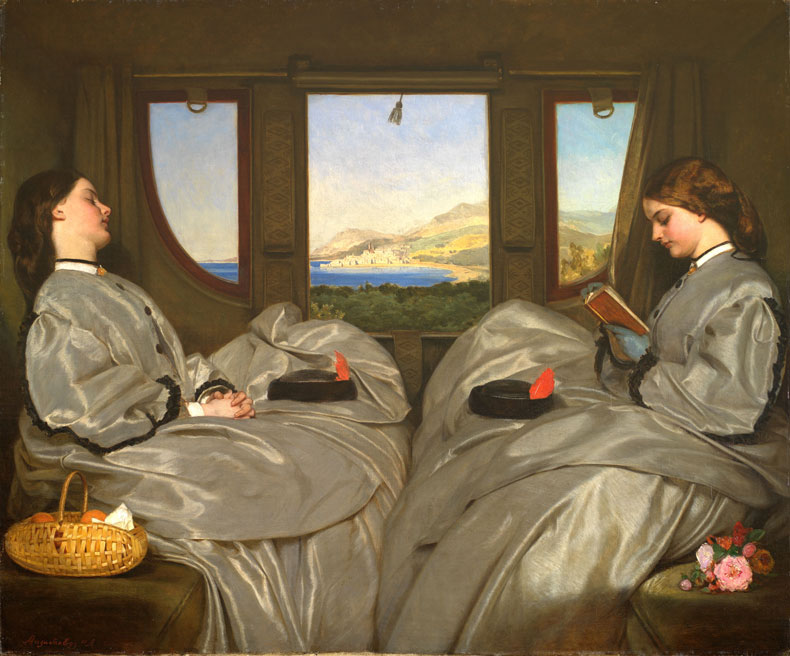 ‘Four things to see’ is sponsored by Bloomberg Connects, the free arts and culture app. Bloomberg Connects lets you access museums, galleries and cultural spaces around the world on demand. Download the app here to access digital guides and explore a variety of content.
‘Four things to see’ is sponsored by Bloomberg Connects, the free arts and culture app. Bloomberg Connects lets you access museums, galleries and cultural spaces around the world on demand. Download the app here to access digital guides and explore a variety of content.
Each week we bring you four of the most interesting objects from the world’s museums, galleries and art institutions, hand-picked to mark significant moments in the calendar.
Throughout history, artists have been inspired by their travels abroad, from the Grand Tour to contemporary artist residencies that facilitate cross-cultural exchange, as well as trips to foreign lands for inspiration and education.
On World Tourism Day, established by the UN’s World Tourism Organisation (now known as UN Tourism) and marked annually on 27 September, we reflect on the complex and evolving role of tourism in global society. Established in 1980, the day underscores the profound impact of tourism on cultural exchange, economic development and international relations. But tourism’s legacy is not without controversy. While it has the potential to enrich lives and foster global understanding, it can also lead to environmental degradation, cultural exploitation and economic disparities within local communities.
As the industry grapples with the challenges of ethical tourism, artists continue to interrogate and reimagine the intersections between travel, culture and identity. Here we look at four works of art that offer different perspectives on a phenomenon that shapes our world in profound ways.

Chimborazo (1864), Frederic Edwin Church. The Huntington Library, Art Museum, and Botanical Gardens, San Marino
Chimborazo (1864), Frederic Edwin Church
The Huntington, San Marino
Frederic Edwin Church’s Chimborazo transports viewers to the landscape of Ecuador, with a formidable volcanic peak in the background and a lush tropical rainforest before it. Church was inspired by naturalist Alexander von Humboldt’s theory of the interdependence of ecosystems and travelled from his home in New York to create paintings such as this. At a time when few could travel so far, works like Chimborazo offered audiences a virtual adventure. The paintings themselves also became travellers, touring the world and drawing crowds eager to witness the fruits of Church’s scientific accuracy and dramatic flair. Find out more on the Bloomberg Connects app by clicking here on your mobile device, or by scanning the QR code at the bottom of this page.

The Travelling Companions (1862), Augustus Leopold Egg. Birmingham Museum and Art Gallery, Birmingham
The Travelling Companions (1862), Augustus Leopold Egg
Birmingham Museum and Art Gallery, Birmingham
In The Travelling Companions by Augustus Leopold Egg, two stylish women sit opposite each other in a first-class train carriage, dressed in matching grey silk gowns. Their symmetrical poses frame the window, through which we catch a glimpse of the Menton coastline on the sun-drenched French Riviera. The painting captures the experience of mid 19th-century tourism and the growing accessibility of European travel by train, while the women’s detachment from the scenery might hint at the passive and removed nature of sightseeing. Click here to find out more.

An untitled mural (n.d.) by an unknown artist in Ihwa Mural Village, Seoul, photographed in 2016. Courtesy KoreaToDo
Untitled mural (n.d.), unknown artist
Ihwa Mural Village, Seoul
In the quiet Seoul neighbourhood of Ihwa Mural Village, colourful murals were commissioned to cover walls, staircases and alleys as part of a 2006 government-led project to revive the area. The artistic reinvigoration proved so popular that residents, mostly elderly ones, became overwhelmed by the noise and crowds. In response to this overtourism, another set of murals appeared, including the one depicted here, encouraging visitors to be respectful of residents and keep the noise down during their artistic pilgrimages to the village. Click here to find out more.

Le Printemps en France (1929), created for the French Ministry of Public Works, Transport and Tourism. Museum of Applied Arts (MAK), Vienna
Le Printemps en France (1929), unknown artist
Museum of Applied Arts (MAK), Vienna
This vibrant travel poster features a jaunty Eiffel Tower rising above Paris, with colourful flowers in the foreground and fluffy white clouds in a bright blue sky. Created in 1929 for France’s Ministry of Public Works, Transport and Tourism, it captures the spirit of inter-war tourism, inspiring wanderlust and adventure during a growing era of leisure travel. Click here to find out more.
![]() ‘Four things to see’ is sponsored by Bloomberg Connects, the free arts and culture app. Bloomberg Connects lets you access museums, galleries and cultural spaces around the world on demand. Download the app here to access digital guides and explore a variety of content or scan the QR code.
‘Four things to see’ is sponsored by Bloomberg Connects, the free arts and culture app. Bloomberg Connects lets you access museums, galleries and cultural spaces around the world on demand. Download the app here to access digital guides and explore a variety of content or scan the QR code.
Unlimited access from just $16 every 3 months
Subscribe to get unlimited and exclusive access to the top art stories, interviews and exhibition reviews.














![Masterpiece [Re]discovery 2022. Photo: Ben Fisher Photography, courtesy of Masterpiece London](http://www.apollo-magazine.com/wp-content/uploads/2022/07/MPL2022_4263.jpg)
The threat to Sudan’s cultural heritage